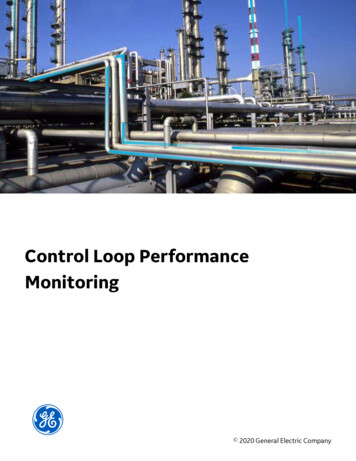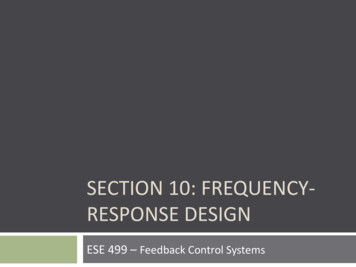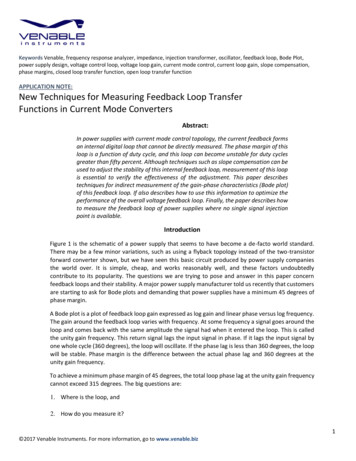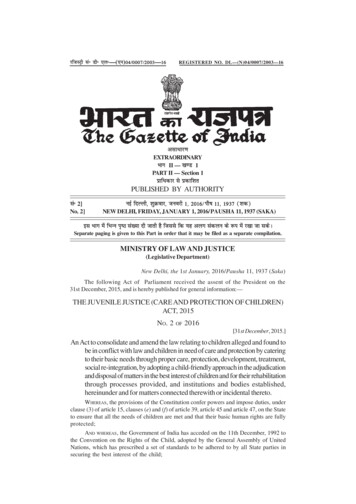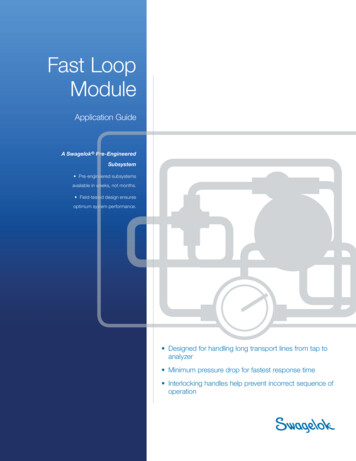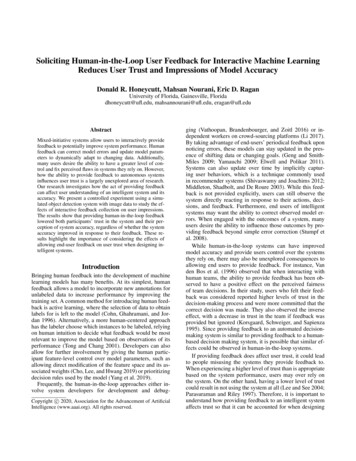
Transcription
Soliciting Human-in-the-Loop User Feedback for Interactive Machine LearningReduces User Trust and Impressions of Model AccuracyDonald R. Honeycutt, Mahsan Nourani, Eric D. RaganUniversity of Florida, Gainesville, Floridadhoneycutt@ufl.edu, mahsannourani@ufl.edu, eragan@ufl.eduAbstractMixed-initiative systems allow users to interactively providefeedback to potentially improve system performance. Humanfeedback can correct model errors and update model parameters to dynamically adapt to changing data. Additionally,many users desire the ability to have a greater level of control and fix perceived flaws in systems they rely on. However,how the ability to provide feedback to autonomous systemsinfluences user trust is a largely unexplored area of research.Our research investigates how the act of providing feedbackcan affect user understanding of an intelligent system and itsaccuracy. We present a controlled experiment using a simulated object detection system with image data to study the effects of interactive feedback collection on user impressions.The results show that providing human-in-the-loop feedbacklowered both participants’ trust in the system and their perception of system accuracy, regardless of whether the systemaccuracy improved in response to their feedback. These results highlight the importance of considering the effects ofallowing end-user feedback on user trust when designing intelligent systems.IntroductionBringing human feedback into the development of machinelearning models has many benefits. At its simplest, humanfeedback allows a model to incorporate new annotations forunlabeled data to increase performance by improving thetraining set. A common method for introducing human feedback is active learning, where the selection of data to obtainlabels for is left to the model (Cohn, Ghahramani, and Jordan 1996). Alternatively, a more human-centered approachhas the labeler choose which instances to be labeled, relyingon human intuition to decide what feedback would be mostrelevant to improve the model based on observations of itsperformance (Tong and Chang 2001). Developers can alsoallow for further involvement by giving the human participant feature-level control over model parameters, such asallowing direct modification of the feature space and its associated weights (Cho, Lee, and Hwang 2019) or prioritizingdecision rules used by the model (Yang et al. 2019).Frequently, the human-in-the-loop approaches either involve system developers for development and debugCopyright c 2020, Association for the Advancement of ArtificialIntelligence (www.aaai.org). All rights reserved.ging (Vathoopan, Brandenbourger, and Zoitl 2016) or independent workers on crowd-sourcing platforms (Li 2017).By taking advantage of end-users’ periodical feedback uponnoticing errors, these models can stay updated in the presence of shifting data or changing goals. (Geng and SmithMiles 2009; Yamauchi 2009; Elwell and Polikar 2011).Systems can also update over time by implicitly capturing user behaviors, which is a technique commonly usedin recommender systems (Shivaswamy and Joachims 2012;Middleton, Shadbolt, and De Roure 2003). While this feedback is not provided explicitly, users can still observe thesystem directly reacting in response to their actions, decisions, and feedback. Furthermore, end users of intelligentsystems may want the ability to correct observed model errors. When engaged with the outcomes of a system, manyusers desire the ability to influence those outcomes by providing feedback beyond simple error correction (Stumpf etal. 2008).While human-in-the-loop systems can have improvedmodel accuracy and provide users control over the systemsthey rely on, there may also be unexplored consequences toallowing end users to provide feedback. For instance, Vanden Bos et al. (1996) observed that when interacting withhuman teams, the ability to provide feedback has been observed to have a positive effect on the perceived fairnessof team decisions. In their study, users who felt their feedback was considered reported higher levels of trust in thedecision-making process and were more committed that thecorrect decision was made. They also observed the inverseeffect, with a decrease in trust in the team if feedback wasprovided but ignored (Korsgaard, Schweiger, and Sapienza1995). Since providing feedback to an automated decisionmaking system is similar to providing feedback to a humanbased decision making system, it is possible that similar effects could be observed in human-in-the-loop systems.If providing feedback does affect user trust, it could leadto people misusing the systems they provide feedback to.When experiencing a higher level of trust than is appropriatebased on the system performance, users may over rely onthe system. On the other hand, having a lower level of trustcould result in not using the system at all (Lee and See 2004;Parasuraman and Riley 1997). Therefore, it is important tounderstand how providing feedback to an intelligent systemaffects trust so that it can be accounted for when designing
human-in-the-loop systems.In this paper, we examine how users perceive system accuracy over time and how their trust in the system changesbased on the presence of interactive feedback. We used asimulated object-detection system that allowed users to provide interactive feedback to correct system errors by adjusting image regions for detected objects. Additionally, toexplore possible implications of how the system respondsto given feedback, our experiment also controlled different types of change in system accuracy over time. Theresults indicate that by providing human-in-the-loop feedback, user trust and perception of accuracy can be negativelyaffected—regardless of whether the system improves afterreceiving feedback.Related WorkIn this section, we consider prior work from the perspectivesof human-in-the-loop machine learning and trust in artificialintelligence.Human-in-the-Loop Machine LearningWhile machine learning can be used to train models basedpurely on data without direct human guidance, there aremany scenarios where incorporating human feedback is beneficial. In many cases, this feedback is simply having a human annotate new data to be incorporated into the model.Relevance feedback is a human-in-the-loop method wherea human reviews the pool of unlabeled data alongside thecurrent model’s predictions on that data, choosing when toprovide new labels to the system based on their own intuition (Tong and Chang 2001). Another approach that canbe taken in domains where human intuition may not resultin optimal selections of what data to label is to choose instances to add to the training set by objective metrics basedon the model. Active learning selects relevant instances toshow to a human, referred to as an oracle, based on whichunlabeled data are most likely to represent information missing in the current version of the model (Cohn, Ghahramani,and Jordan 1996). While theoretical active learning researchtreats the oracle as merely being a way to obtain the truelabels for selected data, in practice, active learning modelsneed to account for the fact that the oracle is a human andtherefore not infallible (Settles 2011).However, human input is not limited to merely providing new labels to data. Explanatory interactive learning hasthe oracle not only provide the appropriate label for the datapoint but also provides an explanation of the current modelprediction and asks the oracle to correct the reasoning inthe explanations (Teso and Kersting 2019). This helps avoidsituations where the model has a flaw that happens to result in the correct prediction by chance. Another form ofadvanced human feedback is to show the oracle model parameters, such as features and their weights (Cho, Lee, andHwang 2019) or rules used to make decisions within themodel (Yang et al. 2019), and allows for direct modificationof those parameters. Being able to control model parameters in this way has been found to be useful for debuggingmodels (Kulesza et al. 2010). While this higher level of control over the model may not be desirable in all applications,Holzinger et al. (2016) showed that human-machine teaming can sometimes result in a closer to optimal model thanmachine learning alone.While the person providing feedback is not necessarilythe end user for many human-in-the-loop systems, there areadvantages to bringing end users into the loop. Stumpf etal. (2008) found that users of intelligent systems largelywant to provide feedback to systems they are using, particularly when it gives them a feeling of being able to control some aspect of the model. Similarly, people are morelikely to use an imperfect intelligent system when they havethe ability to correct its errors (Dietvorst, Simmons, andMassey 2018). Additionally, end users may notice when analready deployed system begins to falter. Even if a modelwas very accurate at the initial time of training, the trainingdata may become less representative of the actual population of data as trends shift over time. This is a phenomenonknown as concept drift (Žliobaitė 2010). A human-in-theloop approach to dealing with this problem is known as incremental learning, where the model periodically obtains labels as they become available to update the model while itis in use (Geng and Smith-Miles 2009). These techniqueshave been shown to effectively address the problem of concept drift in machine learning systems (Yamauchi 2009;Elwell and Polikar 2011).Providing input has been shown to affect trust and perception of fairness in the field of psychology. In decisionmaking teams, people were observed to place more trust ina team-leader who actively considered their input, and theywere also more confident that the correct decision was madeafter the fact (Korsgaard, Schweiger, and Sapienza 1995).A similar effect was observed in procedural decision making systems, with people having a higher level of trust andperception of fairness in a decision-making system that theywere able to give input to (Van den Bos, Vermunt, and Wilke1996). An interesting result from both of these studies wasthat providing feedback had a negative effect on trust if thefeedback was ignored. Since feedback affects interpersonaltrust by improving trust if feedback is considered and decreasing trust if it is ignored, a similar effect may be observed in human-computer interactions.Trust in Artificial IntelligenceUser trust in artificial intelligence systems has been studiedfor many years and is of value since it is directly associated with usage and reliance (Parasuraman and Riley 1997;Siau and Wang 2018). As a result, users need to place anappropriate amount of trust in a system based on its performance in different contexts. Reliance and trust in automatedsystems are not binary (i.e., to trust or not) and are generallymore complex (Lewicki, McAllister, and Bies 1998; Lee andSee 2004). Desired behavior is for a user to examine a system’s outputs and decide whether to rely on the system basedon the accuracy of results (Hoffman et al. 2013). This behavior has been observed to be more prevalent among users whoare domain experts than novice users (Nourani, King, andRagan 2020). Sometimes, however, users might trust a system completely without checking the outcomes, i.e., overreliance or automation bias (Goddard, Roudsari, and Wyatt
Figure 1: In the with interaction conditions, participants could delete existing bounding boxes or click-and-drag to create newones. In this example, the left image shows a system error, and the right shows a version after interactive correction. 12012). This situation can be caused by a user’s lack of confidence or when the system seems more intelligent than theyare based on their initial preconceptions (Lee and See 2004;Hoffman et al. 2013; Nourani et al. 2020a). In contrastingscenarios, mistrust (Parasuraman and Riley 1997) and distrust (Lee and See 2004) can cause users to rely more onthemselves or under-rely on the system. Both of these situations can be dangerous, especially for systems with criticaltasks where decisions can be fatal. For example, wrong decisions in criminal forecast systems can wrongfully convictan innocent person (Berk and Hyatt 2015).To raise users’ trust and provide more information to aidthem in their decision-making process, researchers have explored the use of explainability in artificial intelligence systems (Ribeiro, Singh, and Guestrin 2016). Studies of humanin-the-loop paradigms have shown explainability can helpusers understand and build trust in the algorithms in order toprovide proper feedback and annotations (Ghai et al. 2020;Teso and Kersting 2018).Researchers use different methods to measure trust andreliability in machine learning and artificial intelligence systems. For example, some researchers utilize user’s agreement with the system outputs as a measure of reliance andtrust; specifically, identifying when the user agrees with thesystem outputs that are not correct (Nourani et al. 2020b).Yu et al. (2019) propose a reliance rate based on the number of times the users agreed with the system answers out ofall their decisions. In recent work, Yin et al. (2019) foundthat trust is directly affected by user’s estimations of thesystem’s accuracy, where underestimation of accuracy cancause mistrust in the system, and vice versa. As a result, auser’s estimated or observed accuracy can be used as an indirect measurement for user trust, and we use these methodsin the study reported in this paper.1Image from “Josh McMahon Portraits - 2517” by John Trainor(used under CC BY 2.0) with annotations added by the authors.License available at In this section, we discuss our research objectives basedaround understanding the differences in user trust amongusers of human-in-the-loop systems and non-interactive systems. We also present details of our experimental design andstudy procedure.Research ObjectivesWith the goal of understanding the effects of providinghuman-in-the-loop feedback on user perception of artificially intelligent systems, we identified the following research questions:RQ1: Does user trust in an intelligent system change if theuser provides feedback to the system?RQ2: Does providing feedback to an intelligent system affect user ability to detect changes in system accuracy overtime?To address these research questions, we designed a controlled experiment using a simulated image classificationsystem both with and without feedback. With these different systems, we hypothesized that the effects of participant trust due to interaction presence would be based onsystem response to their feedback, similar to the effectsobserved in human-based decision making systems (Korsgaard, Schweiger, and Sapienza 1995; Van den Bos, Vermunt, and Wilke 1996). If the system reacted positively, improving as the participant provided feedback, we expectedthat participants would feel more invested in the system andas a result, they would trust the system more. However, ifthe system did not honor the user’s feedback and did notimprove after taking participant feedback, we expected thatthey would become negatively biased against the system.Experimental DesignFor our study, we provided participants with a series of images with classifications from a simulated model. To avoidconfusion of whether a system prediction was correct or not,we chose to focus on a domain which required no prior experience, which led us to use detection of human faces as
our classification goal. With the goal of increasing participant engagement in the feedback process, we wanted to use asystem with more intricate outputs than binary classificationalone. Therefore, we decided to simulate a system that detected the location of human faces rather than just their presence, placing bounding boxes over each face in the image.Classifications were hand-crafted, not actually from an artificially intelligent model as participants were told. The taskconsisted of reviewing three rounds of images, with 30 images in each round. The images used in our simulated modelwere taken from the Open Images dataset (Kuznetsova et al.2020; Krasin et al. 2017) with our own manually generatedannotations. Each round of 30 images contained 20 picturesof people, with the remaining 10 images containing thingssuch as animals or empty scenery. For images where wechose to simulate system errors, we used a roughly equivalent mix of false positives (bounding boxes placed on objectsthat were not human faces) and false negatives (unidentifiedhuman faces).Because our main metrics—perception of model accuracyand user trust—are based on participants’ experiences withthe system, we decided that each participant should onlysee one version of the system so as not to be biased bytheir experience with the previous system versions. For thisreason, we used a 2x3 between-subjects design for the experiment. The first independent variable in our experimentwas interaction presence with two levels: with interactionand without interaction. Participants in the with interactioncondition were asked to provide feedback to the model foreach image by correcting any errors, or by verifying that thesystem’s classification was correct. To do this, participantscould interact with the system to removing any boundingboxes from an image that did not contain a human face, andthey could add new bounding boxes over any unidentifiedfaces in the image. Participants in with interaction conditionwere explicitly instructed that their feedback would be usedby the model in-between each round of images to updatethe model’s parameters before classifying the next round ofimages. To maintain a feeling of realism that the model wasactually updating, we added a 45 second pause between eachround and told participants that they would need to wait forthe model to take their feedback into account and update thepredictions for future classifications.The without interaction system removed the ability tointeract with the bounding boxes to correct erroneous instances. In both conditions, to ensure participant engagement in this condition, we asked participants to respondwhether the model’s classification was correct or incorrect.Unlike the participants who saw the interactive system, participants in the without interaction condition were told thattheir responses would be sent to the researchers after thecompletion of the final round of images, with no indicationthat their responses would be used by the model in any way.Our second independent variable was change in accuracy,which corresponded to the simulated accuracy of the systemin each round of images with levels as shown in Table 1:While the change in accuracy factor influenced the distribution of errors over sections of the study, it is important to note that the total number of system errors observedFigure 2: Study procedure overview.by participants across the entire study was the same in allconditions—a total of 18 of 90 images were shown as classified incorrectly regardless of condition. The only differenceamong these conditions was when those errors were shown.ProcedureParticipants completed the experiment using an online webapplication without intervention or live communication withthe researchers. The study began with a pre-study questionnaire, asking basic demographic information including age,gender identification, and educational background. Additionally, we asked participants to self-report their experiencewith machine learning and artificially intelligent systems toensure there was no significant difference between the experience of the populations for each condition. Participantsthen received instructions on completing the task, includingexamples of correct and incorrect classifications of images.Increasing accuracyConstant accuracyDecreasing accuracyRound 170%80%90%Round 280%80%80%Table 1: System accuracy by round.Round 390%80%70%
Figure 3: Perceived accuracy across rounds (error bars show standard error). Participants with interaction (purple) rated thesystem as less accurate than those with no interaction (yellow).To avoid ambiguity as to what constituted a correct classification, we instructed participants to consider any boundingbox that contained a portion of a human face to be correct.Additionally, when designing the outputs of the simulatedmodel we avoided placing any bounding boxes that only partially contained a face. Participants in conditions with interaction also saw a tutorial on how to edit the bounding boxesto provide feedback to the model which reminded them thattheir feedback would be used to update the model betweenrounds.After finishing the instructions and tutorial, participantsmoved on to the main task, which consisted of three roundsof reviewing 30 images with bounding boxes correspondingto the system classifications. Between each set of images,participants were asked to estimate how accurate the system was during the previous set of images. Participants inthe with interaction conditions were required to wait for anadded time delay before being able to continue to the nextround (simulating the time required for the system to updatebased on participant feedback). A notification about the reason for this delay was also shown to remind participants thattheir feedback was being used dynamically (although the actual system remained static regardless of their feedback). After all rounds of images were completed, participants filledout a post-study questionnaire to evaluate their level of trustin the system.ParticipantsParticipants were recruited from Amazon Mechanical Turkwith a requirement for participants to have the Masters qualification, an approval rate of greater than 90%, and 500 ormore prior tasks completed successfully. Participants rangedfrom ages 24–68 and lived in the United States at the timeof study completion. To ensure the quality of participant responses, we measured the percentage of responses for whichparticipants correctly identified whether an image corresponded to a system error or not. As a quality check, participants were not included in the results if they had less than75% accuracy for either correct instances or system errors.Our study had a total of 157 participants, and 4 were removed based on the accuracy criteria. The remaining 153participants consisted of 83 males, 69 females, and one nonbinary response. Participants took approximately 14 minuteson average to complete the study.ResultsIn this section, we present the measures of our study andempirical results. We report statistical test results along with2) for effect sizes of ANOVA testsgeneralized eta squared (ηGand Cohen’s d (ds ) for effect sizes of post-hoc tests.User-Perceived Model AccuracyTo examine the effects of providing interactive feedbackon user-perceived system accuracy, the participants numerically estimated the system accuracy after each round of image review. To account for differences in observed accuracycontrolled by the change in accuracy factor, we analyzed estimated accuracy as the error of participant responses compared to the actual simulated accuracy. Results are shownin Figure 3. A three-way mixed-design ANOVA was performed on the error of estimated accuracy, with change inaccuracy and interaction presence as between subjects factors and image set (i.e., first, second, or third round) as awithin subjects factor. The analysis showed a significant effect of interaction presence on error of estimated accuracy.Participants who provided system feedback estimated thesystem as being less accurate than those who did not providefeedback to the model, with F (1, 147) 6.99, p 0.01,2ηG 0.035. No significant interaction effects were detected.Additionally, the ANOVA test found participant error tobe significantly different based on round with F (2, 294) 210.29, p 0.001, ηG 0.016, as well as an interaction effect between change in accuracy and round with2F (4, 294) 38.19, p 0.001, ηG 0.108. As the simulated accuracy in each round was different based on thechange in accuracy condition, these results are not surprising.Perception of Model ChangeIn addition to the reported accuracy during the task, weasked participants to rate how much they thought the system
SignificantIncreasePerceived Change After TaskSlightIncreaseAverage Agreement With Trust StatementsStronglyAgreeChange inAccuracyNoChangeIncreasingConstantChange asingSlightDecreaseSignificantDecreaseNo InteractionWith InteractionFigure 4: Perceived change in system accuracy from the firstround to the last. Participants who saw an increase in accuracy reported a significantly more positive perceived changein accuracy than those who observed constant accuracy, andthose who saw constant accuracy reported a significantlymore positive change than those who saw decreasing accuracy.had changed across the different rounds on a five-point Likert scale. Figure 4 shows the distribution of participant responses to this measure. We performed an independent twoway factorial ANOVA on participant responses that showedno significance based on interaction presence. However, wedid observe that change in accuracy was significant with2 0.405. A Tukey posthoc testF (2, 147), p 0.001, ηGshowed that each pair was significantly different. Participants who saw increasing accuracy rated the system as having changed significantly more positively than both constantaccuracy (p 0.001, ds 1.366) and decreasing accuracy (p 0.001, ds 1.946). Those who saw constantaccuracy thought that the system had a more positive rate ofchange than participants who observed decreasing accuracy(p 0.05, ds 0.498).User TrustTo measure participants’ trust, we asked participants to ratetheir agreement using a series of scales proposed by Madsen and Gregor that focus on capturing different aspects ofhuman-computer trust (Madsen and Gregor 2000). Participants rated each item on a seven-point Likert scale. Becausethe scales were developed for intelligent systems that aid inuser decision making, we selected the following subset thatapplied most to our system. The following three statementswere shown to all participants, and the aggregate rating wasused as a measure for trust: The system performs reliably. The outputs the system produces are as good as that whicha highly competent person could produce. It is easy to follow what the system does.Additionally, as a simple measure of participants’thoughts on the model updating with feedback, the follow-StronglyDisagreeNo InteractionWith InteractionFigure 5: Average agreement with the three trust statements.Participants with interactions had significantly lower trust,regardless of their observation of change in accuracy.ing was only shown to participants in conditions with interaction: The system correctly uses the information I enter.Aggregated responses for the first three trust items wereanalyzed with a two-way factorial ANOVA testing the effects of interaction presence and accuracy change. Thistest showed that the with interaction condition had significantly lower trust than the without interaction condition with2F (1, 147) 7.61, p 0.01, and ηG 0.049. The test didnot detect a significant effect of change in accuracy on participant trust. The distribution of average participant agreement with the first three trust statements is shown in Figure5.The results from the fourth statement about agreementthat the system correctly used their feedback are shown inFigure 6. Since this measure was only relevant and collectedfor participants in the with interaction conditions, we performed a one-way ANOVA test with change in accuracy asthe only factor. The test revealed a significant effect with2F (2, 75) 3.263, p 0.05, ηG 0.080. From a Tukeyposthoc test, participants who observed an increase in system accuracy had a higher level of agreement that the systemwas updating correctly than those with constant accuracy,with p 0.05, ds 0.725. Thus, participants believed theirfeedback was being used when they corrected the image detection and observed increased accuracy over trial rounds.We did not observe any significant effect between participants who saw a decrease in system accuracy and participants in either of the other conditions.DiscussionThis section discusses the results of the experiment in thecontext of our research questions and hypotheses. We alsoconsider limitations of our experiment and opportunities forfurther work on this subject.
StronglyAgreeConfidence in Feedback easingFigure 6: Participant agreement that the system correctlyused their feedback. Participants with increased accuracywere significantly more confident in correctness of feedbackusage than those with constant accuracy.Interpretation of ResultsOur goal for this study was to explore the effects that providing feedback to an automated system has on both usertrust and perception of system accuracy. In our experiment,we controlled for both presence of interaction and change insystem accuracy. We expected that participants who saw apositive response to their input—an increase in accuracy—would experience an increase in trust and perceived accuracy compared to participants who did not provide feedback.For participants who did not observe a positive response—constant accuracy or a decrease in accuracy—we expectedthe opposite. However, while our analysis did detect a significant effect for presence of interaction on both perceivedaccuracy and trust, the effect did not depend on the observedchange in accuracy as expected. Rather, participants whoprovided feedback to the system perceived the system as lessaccurate and had less trust compared to those who did notprovide feedback, regardless of the observed change in accuracy.This leads us to believe
While the person providing feedback is not necessarily the end user for many human-in-the-loop systems, there are advantages to bringing end users into the loop. Stumpf et al. (2008) found that users of intelligent systems largely want to provide feedback to systems they are using, partic-ularly when it gives them a feeling of being able to con-


